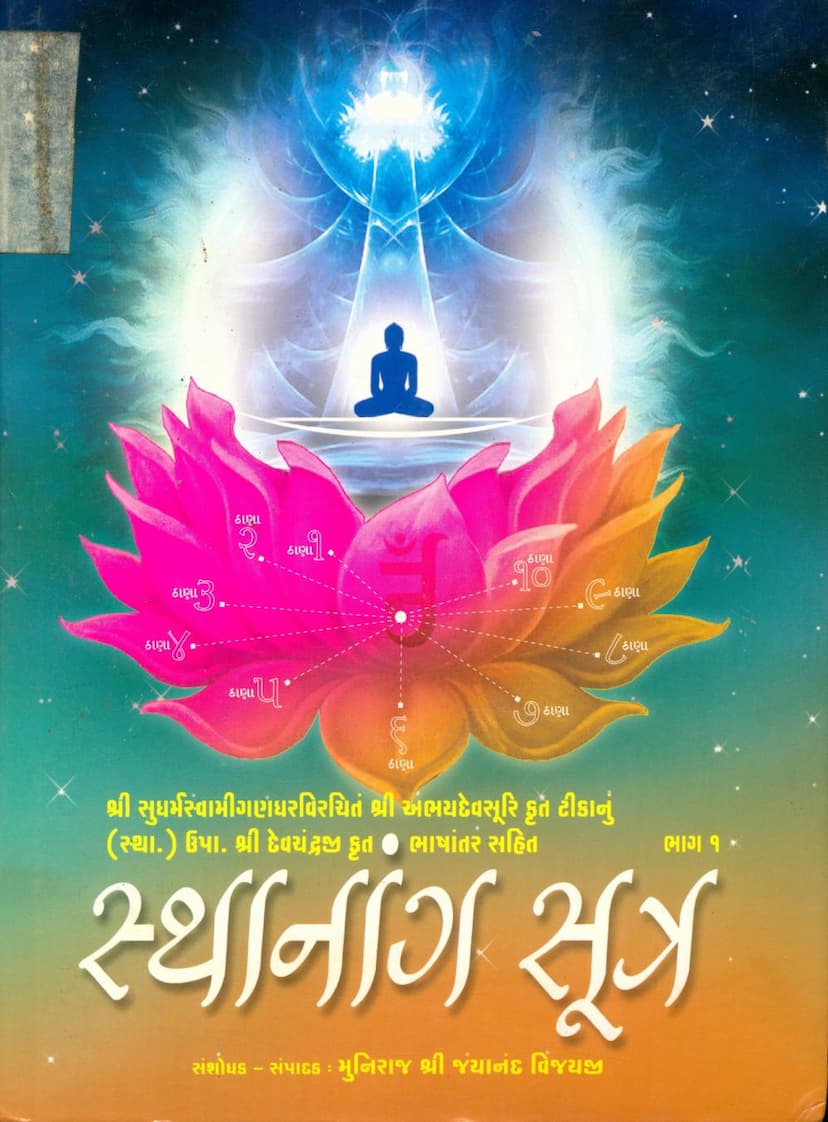Sthanang Sutra Part 01
Added to library: September 2, 2025

Summary
Sthananga Sutra Part 01: A Comprehensive Summary
The Sthananga Sutra, authored by Acharya Muni Shri Jayanand Vijayji and published by Shri Guru Ramchandra Prakashan Samiti, is a foundational text within Jainism. Part 01, as presented, serves as an introductory volume to this extensive scripture, offering a foundational understanding of its structure and core concepts.
Overall Scope and Purpose:
The Sthananga Sutra, meaning "the scripture of places" or "categories," aims to systematically classify and explain Jain teachings through a numerical framework, arranging concepts from one to ten. Part 01 appears to lay the groundwork for this numerical categorization, introducing the core principles and the methodology of the scripture.
Key Themes and Content (Based on provided pages):
-
The Term "Bhagvant": Page 2 highlights a significant discussion on the term "Bhagvant," emphasizing its application to Acharyas, Upadhyayas, and Sadhus. This demonstrates that the scripture views these spiritual leaders as embodying the divine essence, equating them with the Panch Parmeshthi (the five supreme beings) in terms of reverence and spiritual status. The text suggests that the aspiration towards becoming a "Bhagvant" is realized through the mental state and intention.
-
Structure and Organization: Page 4 provides a detailed "Anukram" (Index) outlining the structure of the Sthananga Sutra. It indicates a division into "Adhyayan" (Chapters) and "Uddesha" (Sections) within those chapters. The index lists four chapters, with the first chapter covering sutras 1-56, and subsequent chapters further divided into four sections each, progressing through various numerical categories from one to ten. This highlights the meticulous and organized approach of the text in presenting its teachings.
-
Authorship and Commentary: Pages 5 and 6 clearly state the lineage of the text, attributing the original sutras to Sri Sudharma Swamigandhar Bhagvant, with a commentary by Sri Abhaydev Surishwarji M. and a Gujarati translation by Upadhyay Sri Devchandji (Athakoti Kacchi). Muni Shri Jayanand Vijayji is credited as the researcher and editor of this particular edition. This information is crucial for understanding the historical and interpretive context of the text.
-
Publisher and Sponsorship: Pages 6 and 7 list the publisher, Sri Guru Ramchandra Prakashan Samiti, and a multitude of economic supporters for the publication. This extensive list of patrons suggests the significant effort and community backing involved in making this scripture accessible.
-
Translator's Foreword (Upa. Shri Devchandji M.): Page 9 features a foreword by Upadhyay Sri Devchandji M. He expresses the profound and vast nature of the Agams (Jain scriptures) and the challenges in grasping their profound meanings. He explains the division of Jain scriptures into four "Anuyogas" (perspectives) for better understanding. The foreword details his inspiration for translating the Sthananga Sutra, stemming from his readings and the deep impact of its subject matter, variety, and expositional style. He mentions the assistance of Pandit Gangajibhai and Pandit Krishnakant Jha in grammar and sentence interpretation. He also expresses gratitude to spiritual mentors and financial supporters for their contributions. The foreword highlights the effort to make this ancient text accessible to modern readers through translation.
-
Welcome (Aavkar) by Acharya Shri Munichandrasurishwarji: Pages 10-12 offer a "Welcome" or introduction by Acharya Shri Munichandrasurishwarji. This section delves into the Sthananga Sutra's vastness, estimating its original "pad" (word/syllable) count to be 72,000, with the currently available text being significantly reduced in size over time. It also touches upon scholarly debates regarding the authenticity and changes within the Sthananga Sutra over centuries. The introduction provides a brief overview of the content mentioned in the Samvayanga Sutra, including the establishment of self-time, other-time, soul, non-soul, cosmos, and non-cosmos, along with definitions from the perspective of substance, attributes, place, time, and state. It also mentions the inclusion of descriptions of mountains, water, celestial abodes, mines, rivers, treasures, great personalities, and astronomical movements. The text further emphasizes the book's adherence to the commentary of Acharya Abhaydev Suri, noting the difficulty of the task due to the text's vast subject matter, varied readings, and numerous impurities, but commends the commentator for providing analysis, philosophical discussions, and supporting verses.
-
Introductory Chapters (Shastra Prastavana): Pages 13-27 contain what appears to be the introductory sections (Shastra Prastavana) of the first chapter. These passages detail the auspicious beginnings (Mangala Dwar), the purpose (Phal), the connection (Yog), and the classification (Nikshep) of the scripture. They explain the necessity of Mangala (auspicious beginnings) at the start, middle, and end of a text for smooth completion and continuity. The text then elaborates on the different meanings of "Sthan" (place/category) and "Ang" (limb/part), outlining fifteen types of "Sthan" and four types of "Ang." The "Samudayarth" (collective meaning) of "Sthananga" is also discussed, emphasizing its role as a knowledge repository covering various subjects from one to ten. The text also begins to discuss the "Anuyog Dwar" (analytical perspectives) – Upakram (commencement), Nikshep (classification), Anugam (succession), and Nay (logic) – as essential tools for understanding the sutras.
-
First Sutras (Sutra 1): Pages 13 and onwards begin the actual exposition of the sutras, starting with the formula "Siddhantam Sampragatam Mahavir Paramaatmane Namaha." The initial explanations focus on the importance of understanding the scripture's purpose, the guru-disciple relationship, and the process of learning. It also delves into the philosophical concept of the soul (Atma) and its nature, discussing its unity and multiplicity through different perspectives (Nayas). The commentary meticulously breaks down the meaning of terms and concepts, providing a deep dive into the foundational Jain philosophy.
In essence, this first part of the Sthananga Sutra serves as a comprehensive introduction to the text's structure, philosophical underpinnings, and the methodology of its study, emphasizing the systematic numerical approach to understanding Jain doctrine. It highlights the importance of scriptural commentary and the dedication of scholars and patrons in preserving and disseminating this valuable religious literature.